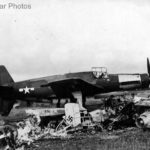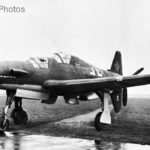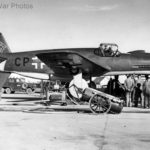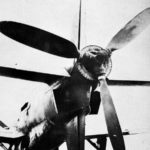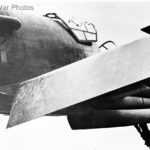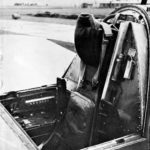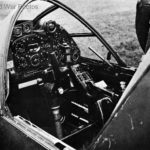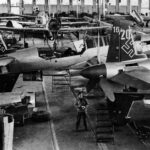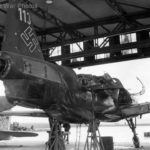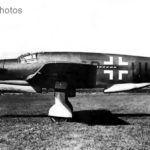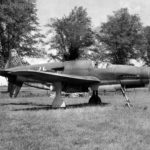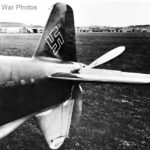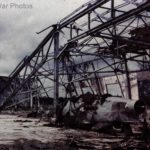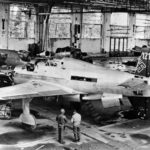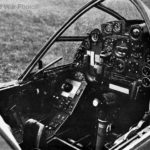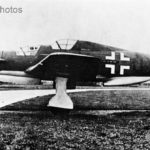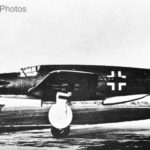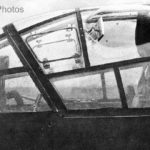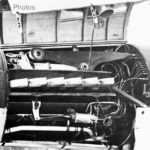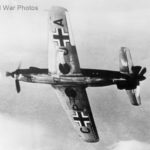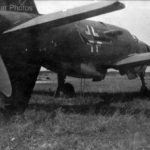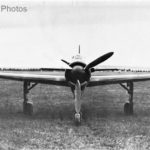Captured by U.S. forces Do 335 Pfeil W.Nr. 240161 1945
Two-seater trainer variant Do 335 M11 Ameisenbär CP+UL
The Do 335 V1 first prototype, CP+UA, 1943
Do 335 Pfeil rear push-propeller
Dornier Do 335 A-07 Pfeil W.Nr. 240107, 1944
Do 335 landing flap
Ejection seat of the Do 335 Pfeil
Do 335 cockpit 2
Do 335 A-12 240114, dual-seat trainer version for the A-series aircraft
Unfinished Do 335s at Dornier plant, Oberpfaffenhofen
Do 335 V3 T9+ZH W.Nr. 230003 of the 1./Versuchsverband OKL
Do 335 A-1 Pfeil W.Nr. 240113 at Bindbach, 1945
Do 335 V3 T9+ZH W.Nr. 230003 of the 1./Versuchsverband OKL 2
unfinished Do 335s at Oberpfaffenhofen Germany
Captured Dornier Do 335 A-1 Pfeil, 1945
Dornier Do 335 V9 CP+UI W.Nr. 230009
Damaged by shell or bomb splinters Do 335A-05 Pfeil W.Nr. 240105
Tail of a Do 335 V3
fuselage in Dornier plant at Oberpfaffenhofen
Captured two-seater Do 335 A-12 “Ameisenbär” W.Nr. 240121 at Oberpfaffenhofen
The cockpit interior of a Dornier Do 335 Pfeil
Do 335 M11 CP+UL 2
Prototype Do335 V1 Pfeil W.Nr. 230001
Do 335 a view of the canopy
Dornier Do 335 engine DB603
Prototype Do 335 V1 Pfeil CP+UA in flight
Dornier Do 335 A-05 Pfeil VG+PK W.Nr. 240105 and Ar 234, 1945
Abandoned Do 335, 1945
Dornier Do 335 V3 front view
The Dornier Do 335 was a German World War II heavy fighter built by the Dornier company. Pfeil was powered by Daimler Benz DB603 engine in the nose, with second engine buried in the rear fuselage driving a propeller behind the tail via an extension shaft.
Type
- Twin-engined day fighter, fighter-bomber, or night fighter.
Wings
- Low-wing cantilever monoplane with a trapezoidal plan form.
- 13.7° sweep-back on the leading-edge and blunt wing-tips.
- Detachable wings with an all-metal stressed-skin structure built around a single box spar.
- Variable camber flaps inboard of the ailerons.
- De-icing on leading-edge.
- Stowage for master compass, hydraulic tanks, oxygen bottles, and inner and outer fuel tanks in wings.
Fuselage
- All-metal monocoque structure.
Tail Unit
- Cruciform type with cantilever tailplane and upper and lower fins and rudders.
- All-metal stressed-skin construction.
- Leading-edges of fins are wooden and house radio aerials.
- De-icing on tailplane leading-edges.
- Rudders and elevators are both aerodynamically and mass-balanced.
Landing Gear
- Retractable tricycle type.
- Main wheels retract inwardly into the underside of the wings.
- Nose wheel retracts backwards and turns through 45° to lie at this angle under the pilot’s seat.
- Hydraulic retraction.
Power Plant
- Two Daimler-Benz DB 603 E twelve-cylinder inverted Vee liquid-cooled engines.
- One engine in the nose driving a tractor airscrew.
- One engine in the fuselage amidships driving a pusher propeller through a long hollow shaft.
- Some versions feature a reversible-pitch front airscrew.
- Annular nose radiator for the front engine and ventral scoop radiator for the rear engine.
- Fuel tanks in A-0 and A-1 entirely in wings with a total capacity of 407 Imp. gallons.
- Fuel tanks in A-6 are in wings and fuselage between two cockpits with a total capacity of 510 Imp. gallons.
- M 50 tanks (33 Imp. gallons) in wings.
Accommodation
- Pilot’s cockpit over the leading-edge of the wing.
- In the two-seat version, the second cockpit is behind and slightly above the pilot for better forward vision.
- Jettisonable cockpit canopy and pilot-ejecting seat.
- Bullet-proof windscreen and armor protection.
Armament
- Day fighter: three MK 103 and two MG 151/20.
- Night fighter: two MG 151/20 in the top cowling and one MK 103 firing through the airscrew shaft.
Dimensions
- Span: 45 ft. 4 in. (13.8 m)
- Length: 45 ft. 6 in. (13.87 m)
- Height: 16 ft. 3.5 in. (5 m)
- Wing area: 414 sq. ft. (38.5 sq. m)
Weight
- Loaded (A-0 and A-1): 21,160 lbs. (9,610 kg)
- Loaded (A-6): 22,230 lbs. (10,090 kg)
Performance (A-0 and A-1)
- Maximum emergency speed: 477 mph (763 km/h) at 21,000 ft. (6,400 m)
- Cruising speed at maximum continuous power: 428 mph (685 km/h) at 23,300 ft. (7,110 m)
- Economical cruising speed at 19,680 ft. (6,000 m): 295 mph (472 km/h)
- Landing speed: 109 mph (174.4 km/h)
- Range and endurance at maximum continuous power: 868 miles (1,390 km) or 2 hours
- Range and endurance at economical cruising power: 1,280 miles (2,050 km) or 2 hours 26 minutes
- Service ceiling at mean weight: 37,400 ft. (11,410 m)
- Normal landing run: 689 yards (630 m)
- Landing run with reversible-pitch airscrew in nose: 514 yards (470 m)
Performance (A-6)
- Maximum emergency speed: 430 mph (688 km/h) at 17,700 ft. (5,500 m)
- Cruising speed at maximum continuous power: 769 mph (606 km/h) at 23,300 ft. (7,110 m)
- Economical cruising speed at 19,680 ft. (6,000 m): 275 mph (444 km/h)
- Landing speed: 112 mph (179 km/h)
- Range and endurance at maximum continuous power: 886 miles (1,420 km) or 2 hours 26 minutes
- Range and endurance at economical cruising power: 1,290 miles (2,065 km) or 4 hours 46 minutes
- Service ceiling at mean weight: 33,400 ft. (10,190 m)
- Landing run: 766 yards (700 m)
- Landing run with reversible-pitch airscrew in nose: 580 yards (530 m)
